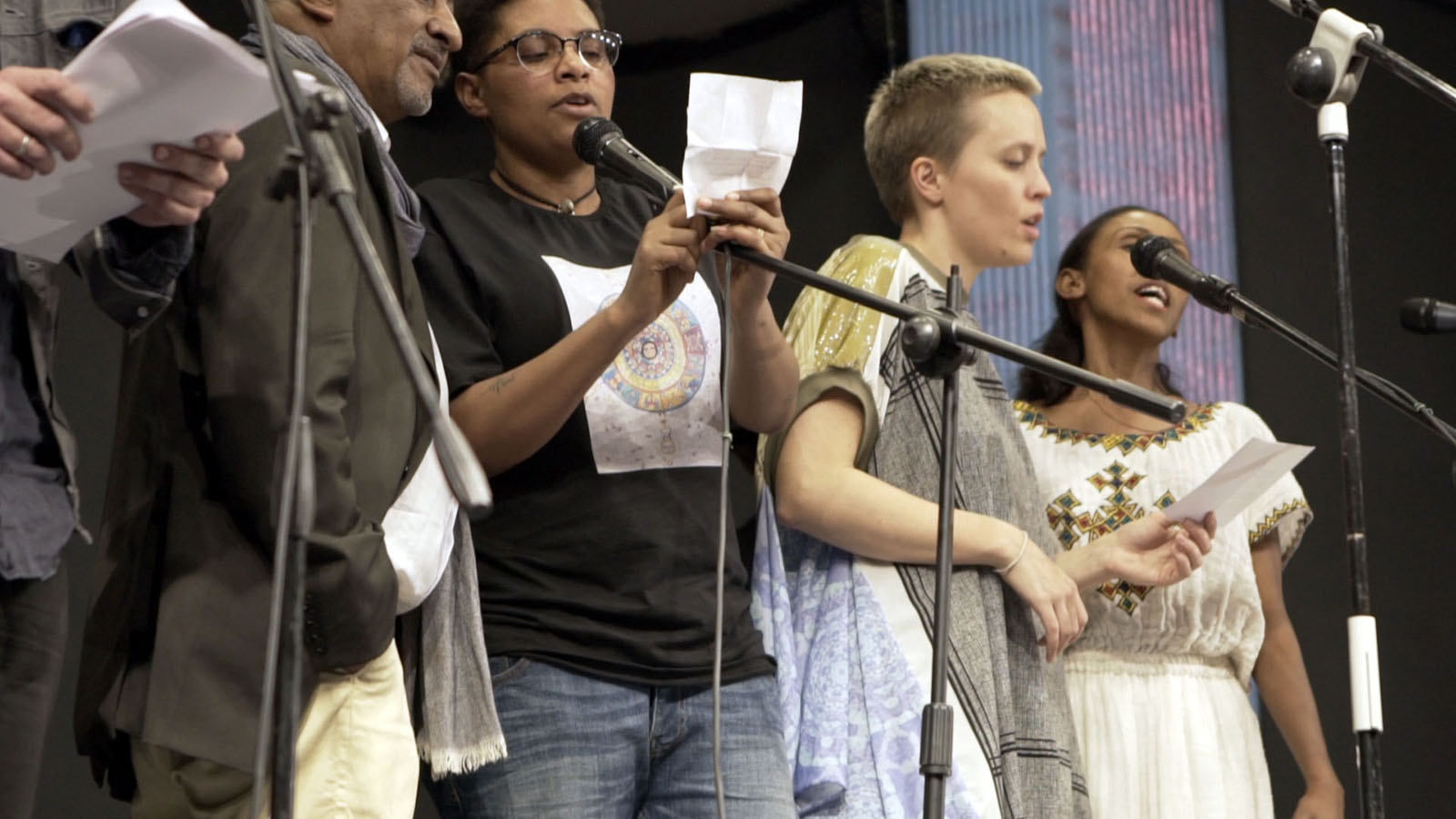
Poetry Jazz: Wax and Gold. Films
Making of Poetry Jazz: Wax and GoldFilms by Clara Jo
Clara Jo documented the workshops and concerts for the long-term Poetry collaboration between the Institut für Raumexperimente (Berlin) and Tobiya Poetic Jazz (Addis Ababa). As a filmmaker, she focused on the sensual and aural qualities in the participants‘ physical and linguistic search for common vernacular expressions, particularly lending her eyes and ears to the gaps of literal translation. In these artistic making-of films, she follows the rehearsal and production process and offers a glance behind the scenes to the dynamics between stage and audience.
–
Poetry Jazz: Solid Gold (2019)
Director: Clara Jo; Featuring: Frezer Admasu, Eric Ellingsen, Mihret Kebede, Robert Lippok, Nebiy Mekonnen, Jorga Mesfin, Neo Muyanga, Solomon Sahle Tizazu, Rike Scheffler, Misrak Terefe, Rediet Terefe Wegayehu, Tasew Wendem Mose, Christina Werner.
Poetry Jazz: Solid Gold, a film by Clara Jo
–
Poetry Jazz: The Rehearsal (2019)
Director: Clara Jo; Featuring: Frezer Admasu, Eric Ellingsen, Mihret Kebede, Robert Lippok, Nebiy Mekonnen, Jorga Mesfin, Neo Muyanga, Solomon Sahle Tizazu, Rike Scheffler, Misrak Terefe, Rediet Terefe Wegayehu, Tasew Wendem Mose, Christina Werner.
Poetry Jazz: The Rehearsal, a film by Clara Jo
–
Poetry Jazz: Wax and Gold (2018)
Director: Clara Jo; Featuring: Frezer Admasu, Eric Ellingsen, Mihret Kebede, Robert Lippok, Nebiy Mekonnen, Jorga Mesfin, Tasew Wendem Mose, Cia Rinne, Rike Scheffler, Misrak Terefe, Christina Werner.
Poetry Jazz: Wax and Gold, a film by Clara Jo
These films are part of the poetry series Poetry Jazz: Wax and Honey, I’m Home by the Institut für Raumexperimente, Berlin; in cooperation with the Akademie der Künste, Berlin; in dialogue with Tobiya Poetic Jazz, Addis Ababa; choreographed by Christina Werner; supported by the Studio Olafur Eliasson, Berlin; Graham Foundation for Advanced Studies in the Fine Arts, Chicago; Co-financing Fund of the Senate Department for Culture and Europe, Berlin. Funded by the TURN Fund of the German Federal Cultural Foundation.
–
A-B-A-B-A: from here to hear (2016)
Director: Clara Jo; Featuring: Gashahn Abateneh, Eric Ellingsen, Mihret Kebede, Erica Licht, Robert Lippok, Nebiy Mekonnen, Abebaw Melaku, Jorga Mesfin, Ari Benjamin Meyers, Bekele Mekonnen, Rike Scheffler, Misrak Terefe, Christina Werner, Uljana Wolf, The Moseb Traditional Music Band, Addis Ababa.
A-B-A-B-A: from here to hear, a film by Clara Jo
–
Roter Salon. A-B-A-B-A: from hear to here (2014)
Director: Clara Jo; Featuring: Eric Ellingsen, Mihret Kebede, Robert Lippok, Abebaw Melaku, Jorga Mesfin, Ari Benjamin Meyers, Rike Scheffler, Misrak Terefe, Christina Werner, Uljana Wolf.
Roter Salon. A-B-A-B-A: from hear to here, a film by Clara Jo
These films are part of the event series A-B-A-B-A : from hear to here as part of Acting Archives, a project initiated by Institut für Raumexperimente, Berlin University of the Arts together with the Alle School of Fine Arts and Design, Addis Ababa University. The project is choreographed by Christina Werner and Eric Ellingsen; realized together with Palais Wittgenstein at Roter Salon at Volksbühne Berlin and the Alliance Ethio-Française d’Addis-Abeba. It is supported by Studio Olafur Eliasson and funded by the TURN Fund of the German Federal Cultural Foundation.
Making of Poetry Jazz: Wax and GoldFilme von Clara Jo
Clara Jo hielt die Workshops und Konzerte der langfristig angelegten Poetry Jazz Kooperation zwischen dem Institut für Raumexperimente, Berlin und Tobiya Poetic Jazz, Addis Abeba mit der Kamera fest. Als Filmemacherin stellte sie dabei das Sinnliche und Aurale in der körperlichen wie sprachlichen Suche der Teilnehmer:innen nach gemeinsamen und doch eigenen Ausdrucksformen in den Fokus, insbesondere schenkte sie dabei den beim Übersetzen entstehenden Sollbruchstellen ihre Aufmerksamkeit. In ihre künstlerischen Making-ofs begleitet sie die Proben- und Produktionsprozesse und ermöglicht einen Blick hinter die Kulissen und folgt den Dynamiken, die den Resonanzraum zwischen Bühne und Publikum in Schwingung versetzten.
–
Poetry Jazz: Solid Gold (2019)
Regie: Clara Jo; mit Frezer Admasu, Eric Ellingsen, Mihret Kebede, Robert Lippok, Nebiy Mekonnen, Jorga Mesfin, Neo Muyanga, Solomon Sahle Tizazu, Rike Scheffler, Misrak Terefe, Rediet Terefe Wegayehu, Tasew Wendem Mose, Christina Werner.
Poetry Jazz: Solid Gold, a film by Clara Jo
–
Poetry Jazz: The Rehearsal (2019)
Regie: Clara Jo; mit Frezer Admasu, Eric Ellingsen, Mihret Kebede, Robert Lippok, Nebiy Mekonnen, Jorga Mesfin, Neo Muyanga, Solomon Sahle Tizazu, Rike Scheffler, Misrak Terefe, Rediet Terefe Wegayehu, Tasew Wendem Mose, Christina Werner.
Poetry Jazz: The Rehearsal, a film by Clara Jo
–
Poetry Jazz: Wax and Gold (2018)
Regie: Clara Jo; mit Frezer Admasu, Eric Ellingsen, Mihret Kebede, Robert Lippok, Nebiy Mekonnen, Jorga Mesfin, Tasew Wendem Mose, Cia Rinne, Rike Scheffler, Misrak Terefe, Christina Werner.
Poetry Jazz: Wax and Gold, a film by Clara Jo
Die Filme sind im Rahmen der Veranstaltungsreihe Poetry Jazz: Wax and Honey, I’m Home des Instituts für Raumexperimente in Berlin entstanden, im Dialog mit Tobiya Poetic Jazz aus Addis Abeba und realisiert in Zusammenarbeit mit der Akademie der Künste in Berlin. Das Projekt wurde durch den Kofinanzierungsfonds der Senatsverwaltung für Kultur und Europa in Berlin und die Graham Foundation for Advanced Studies in the Fine Arts in Chicago unterstützt. Es wurde finanziert durch den Fonds TURN der Kulturstiftung des Bundes.
–
A-B-A-B-A: from here to hear (2016)
Regie: Clara Jo; mit Gashahn Abateneh, Eric Ellingsen, Mihret Kebede, Erica Licht, Robert Lippok, Nebiy Mekonnen, Abebaw Melaku, Jorga Mesfin, Ari Benjamin Meyers, Bekele Mekonnen, Rike Scheffler, Misrak Terefe, Christina Werner, Uljana Wolf, The Moseb Traditional Music Band, Addis Ababa.
A-B-A-B-A: from here to hear, a film by Clara Jo
–
Roter Salon. A-B-A-B-A: from hear to here (2014)
Regie: Clara Jo; mit Eric Ellingsen, Mihret Kebede, Robert Lippok, Abebaw Melaku, Jorga Mesfin, Ari Benjamin Meyers, Rike Scheffler, Misrak Terefe, Christina Werner, Uljana Wolf.
Roter Salon. A-B-A-B-A: from hear to here, a film by Clara Jo
Die Filme sind im Rahmen der Veranstaltungsreihe A-B-A-B-A : from hear to here entstanden als Teil des Projekts Acting Archives, initiiert durch das Institut für Raumexperimente, Universität der Künste Berlin in Zusammenarbeit mit der Alle School of Fine Arts and Design, Addis Ababa University. Das Projekt ist von Christina Werner and Eric Ellingsen choreographiert, realisiert mit der Unterstützung der Alle School of Fine Arts and Design der Universität Addis Abeba, der Alliance Ethio-Française d’Addis Abeba, dem Palais Wittgenstein im Roten Salon der Volksbühne Berlin und dem Studio Olafur Eliasson in Berlin. Es wurde finanziert durch den Fonds TURN der Kulturstiftung des Bundes.
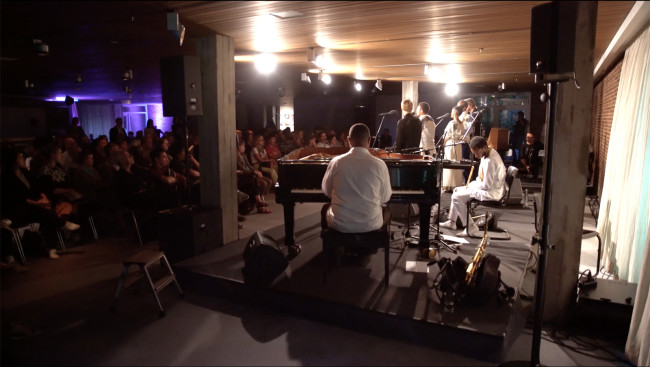
Poetry Jazz: Wax and Gold. A film by Clara Jo
Poetry Jazz: Wax and GoldMaking Of
Premiere
Screening at Ras Hotel, Addis Ababa, 5.30 pm
Poetry Jazz: Wax and Gold (2018) is a short film by Clara Jo, following the workshop and presentation that brought together poets, musicians, artists, and translators from Addis Ababa and Berlin at the Akademie der Künste Berlin in 2017.
Credits
Director, Camera, Edit: Clara Jo; Additional Camera, Edit: Adam Hermansen; Choreographed by Christina Werner. Featuring: Frezer Admasu, Eric Ellingsen, Mihret Kebede, Robert Lippok, Nebiy Mekonnen, Jorga Mesfin, Tasew Wendem Mose, Cia Rinne, Rike Scheffler, Misrak Terefe.
–
This event is part of the poetry series “Poetry Jazz: Wax and Honey, I’m Home” by the Institut für Raumexperimente, Berlin; in cooperation with the Akademie der Künste, Berlin; in dialogue with Tobiya Poetic Jazz, Addis Ababa; choreographed by Christina Werner; supported by the Studio Olafur Eliasson, Berlin; Graham Foundation for Advanced Studies in the Fine Arts, Chicago; Co-financing Fund of the Senate Department for Culture and Europe, Berlin
Funded by the TURN Fund of the German Federal Cultural Foundation.
Poetry Jazz: Wax and GoldMaking Of
Premiere
Screening at Ras Hotel, Addis Ababa, 5.30 pm
Poetry Jazz: Wax and Gold (2018) is a short film by Clara Jo, following the workshop and presentation that brought together poets, musicians, artists, and translators from Addis Ababa and Berlin at the Akademie der Künste Berlin in 2017.
Credits
Director, Camera, Edit: Clara Jo; Additional Camera, Edit: Adam Hermansen; Choreographed by Christina Werner. Featuring: Frezer Admasu, Eric Ellingsen, Mihret Kebede, Robert Lippok, Nebiy Mekonnen, Jorga Mesfin, Tasew Wendem Mose, Cia Rinne, Rike Scheffler, Misrak Terefe.
–
This event is part of the poetry series “Poetry Jazz: Wax and Honey, I’m Home” by the Institut für Raumexperimente, Berlin; in cooperation with the Akademie der Künste, Berlin; in dialogue with Tobiya Poetic Jazz, Addis Ababa; choreographed by Christina Werner; supported by the Studio Olafur Eliasson, Berlin; Graham Foundation for Advanced Studies in the Fine Arts, Chicago; Co-financing Fund of the Senate Department for Culture and Europe, Berlin
Funded by the TURN Fund of the German Federal Cultural Foundation.
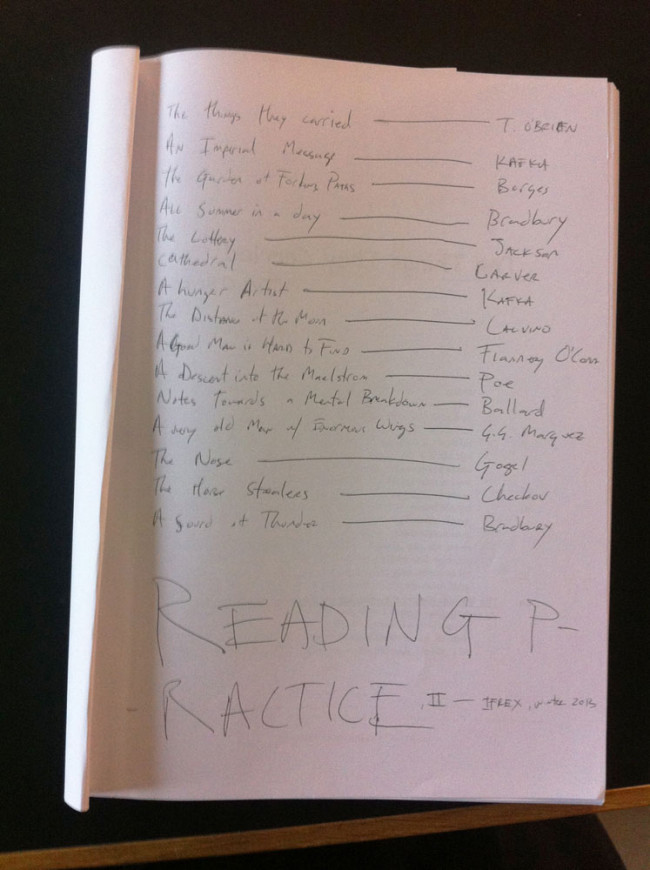
Reading Practice – Short Stories
Reading Seminar with Christina Werner & Eric Ellingsen
READING MATERIAL
Ballard, J. G., „Notes Towards a Mental Breakdown“, in: ders., The Complete Stories of J. G. Ballard, New York 2009, o. S.
Borges, Jorge Luis, „The Garden of Forking Paths“, in: ders., Fictiones, London 1974, o. S.
Bradbury, Ray, A Sound of Thunder, New York 2005.
Calvino, Italo, Cosmicomics, New York 1968.
Carver, Raymond, Cathedral: Stories, New York 1983.
Chekhov, Anton Pavlovich, The Horse-Stealers and Other Stories, New York 1986.
Gogol, Nikolai, „The Nose“, in: ders., Diary of a Madman and Other Stories, Harmondsworth 1987, o. S.
Jackson, Shirley, „The Lottery“, in: ders., Novels and Stories, New York 2010, o. S.
Kafka, Franz, A Hunger Artist and Other Stories, Oxford und New York 2012.
Marquez, Gabriel Garcia, A Very Old Man with Enormous Wings, Cambridge 2007.
O’Brien, Tim, „The Things they Carried“, in: Tobias Wolff (Hrsg.), The Vintage Book of Contemporary American Short Stories, New York 1994, S. 366–384.
O’Conner, Flannery, A Good Moon Is Hard to Find, New Brunswick 1993.
Lektürepraxis mit Christina Werner & Eric Ellingsen
LITERATURAUSWAHL
Ballard, J. G., „Notes Towards a Mental Breakdown“, in: ders., The Complete Stories of J. G. Ballard, New York 2009, o. S.
Borges, Jorge Luis, „The Garden of Forking Paths“, in: ders., Fictiones, London 1974, o. S.
Bradbury, Ray, A Sound of Thunder, New York 2005.
Calvino, Italo, Cosmicomics, New York 1968.
Carver, Raymond, Cathedral: Stories, New York 1983.
Chekhov, Anton Pavlovich, The Horse-Stealers and Other Stories, New York 1986.
Gogol, Nikolai, „The Nose“, in: ders., Diary of a Madman and Other Stories, Harmondsworth 1987, o. S.
Jackson, Shirley, „The Lottery“, in: ders., Novels and Stories, New York 2010, o. S.
Kafka, Franz, A Hunger Artist and Other Stories, Oxford und New York 2012.
Marquez, Gabriel Garcia, A Very Old Man with Enormous Wings, Cambridge 2007.
O’Brien, Tim, „The Things they Carried“, in: Tobias Wolff (Hrsg.), The Vintage Book of Contemporary American Short Stories, New York 1994, S. 366–384.
O’Conner, Flannery, A Good Moon Is Hard to Find, New Brunswick 1993.
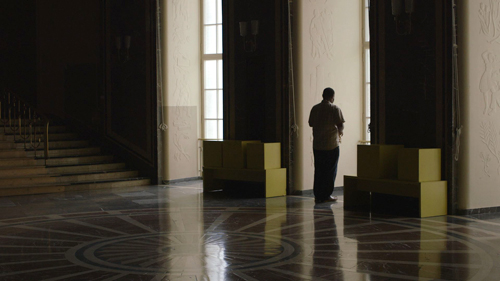
A-B-A-B-A : from here to hear. A film by Clara Jo
A-B-A-B-A: from here to hear. A film by Clara Jo
The collaboration ‚A-B-A-B-A : from hear to here‘ evolved as a series of workshops and poetry events in Addis Ababa and Berlin starting in 2012. Testing new structures and methods in an artistic dialogue, the series set out to explore oral traditions in Amharic poetry culture, translations and interpretations between German, English and Amharic, and performative elements on stage, including traditional Ethiopian music combined with contemporary jazz elements and electronic music. Clara Jo’s film A-B-A-B-A : from here to hear follows the participating artists from stage to stage, from Volksbühne Berlin (July 2014) and the Alliance Ethio-Française d’Addis-Abeba (February 2015), and features interviews which reflect on various traditions within contemporary practice.
—
A-B-A-B-A : from here to hear (2016)
Director: Clara Jo
Featuring: Gashahn Abateneh, Eric Ellingsen, Mihret Kebede, Erica Licht, Robert Lippok, Nebiy Mekonnen, Abebaw Melaku, Jorga Mesfin, Ari Benjamin Meyers, Bekele Mekonnen, Rike Scheffer, Misrak Terefe, Christina Werner, Uljana Wolf, The Moseb Traditional Music Band, Addis Ababa.
Credits
Director: Clara Jo; DP: Michael Laakmann; Camera Assistant: Christopher Haug; Sound Recordists: Montse Torredà Martí, Nicholas Ricciardi, Clara Jo; Edit: Clara Jo, Carolina Hellsgård; Translator: Temesgen H. Dadi; Advisor: Christina Werner; Featuring: Eric Ellingsen, Mihret Kebede, Robert Lippok, Abebaw Melaku, Jorga Mesfin, Ari Benjamin Meyers, Rike Scheffler, Misrak Terefe, Uljana Wolf.
—
The event series A-B-A-B-A : from hear to here is part of the project Acting Archives, a collaboration initiated by Institut für Raumexperimente, Berlin University of the Arts together with the Alle School of Fine Arts and Design, Addis Ababa University. The series is choreographed by Christina Werner and Eric Ellingsen; realized together with Palais Wittgenstein/Roter Salon at Volksbühne Berlin and the Alliance Ethio-Française d’Addis-Abeba. It is supported by Studio Olafur Eliasson, and funded by the TURN Fund of the German Federal Cultural Foundation.
A-B-A-B-A: from here to hear. A film by Clara Jo
The collaboration ‚A-B-A-B-A : from hear to here‘ evolved as a series of workshops and poetry events in Addis Ababa and Berlin starting in 2012. Testing new structures and methods in an artistic dialogue, the series set out to explore oral traditions in Amharic poetry culture, translations and interpretations between German, English and Amharic, and performative elements on stage, including traditional Ethiopian music combined with contemporary jazz elements and electronic music. Clara Jo’s film A-B-A-B-A : from here to hear follows the participating artists from stage to stage, from Volksbühne Berlin (July 2014) and the Alliance Ethio-Française d’Addis-Abeba (February 2015), and features interviews which reflect on various traditions within contemporary practice.
—
A-B-A-B-A : from here to hear (2016)
Director: Clara Jo
Featuring: Gashahn Abateneh, Eric Ellingsen, Mihret Kebede, Erica Licht, Robert Lippok, Nebiy Mekonnen, Abebaw Melaku, Jorga Mesfin, Ari Benjamin Meyers, Bekele Mekonnen, Rike Scheffer, Misrak Terefe, Christina Werner, Uljana Wolf, The Moseb Traditional Music Band, Addis Ababa.
Credits
Director: Clara Jo; DP: Michael Laakmann; Camera Assistant: Christopher Haug; Sound Recordists: Montse Torredà Martí, Nicholas Ricciardi, Clara Jo; Edit: Clara Jo, Carolina Hellsgård; Translator: Temesgen H. Dadi; Advisor: Christina Werner; Featuring: Eric Ellingsen, Mihret Kebede, Robert Lippok, Abebaw Melaku, Jorga Mesfin, Ari Benjamin Meyers, Rike Scheffler, Misrak Terefe, Uljana Wolf.
—
The event series A-B-A-B-A : from hear to here is part of the project Acting Archives, a collaboration initiated by Institut für Raumexperimente, Berlin University of the Arts together with the Alle School of Fine Arts and Design, Addis Ababa University. The series is choreographed by Christina Werner and Eric Ellingsen; realized together with Palais Wittgenstein/Roter Salon at Volksbühne Berlin and the Alliance Ethio-Française d’Addis-Abeba. It is supported by Studio Olafur Eliasson, and funded by the TURN Fund of the German Federal Cultural Foundation.
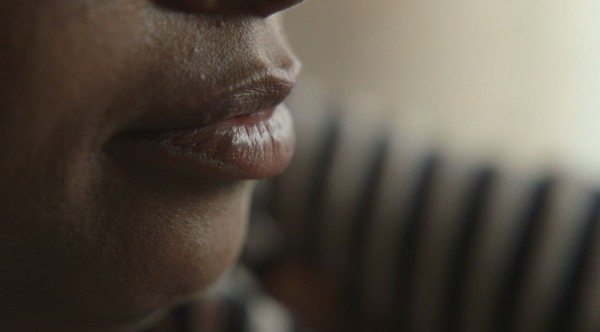
Roter Salon. A-B-A-B-A: from hear to here. Ein Film von Clara Jo
Roter Salon. A-B-A-B-A: from hear to here, a film by Clara Jo
Roter Salon. A-B-A-B-A: from hear to here (2014)
A film by Clara Jo
As a continuation of the poetry event “Ishe get ‚um, OK Poetry” held at Jan Meda Field in 2012, members of the Poetic Jazz Group collaborate with Berlin-based poets, artists and musicians in an experimental workshop, the aim of which had been to translate and transcribe contemporary poetry practices back into performance. The film follows this three-day-long workshop and presentation of poetry jazz concert that brought together poets, musicians, artists, and translators from Addis Ababa and Berlin at Roter Salon/Volksbühne in Berlin, 2014.
—
The event series A-B-A-B-A : from hear to here is a collaboration initiated by Institut für Raumexperimente, Berlin University of the Arts as part of the project Acting Archives. Choreographed by Christina Werner and Eric Ellingsen; realized together with Palais Wittgenstein/Roter Salon at Volksbühne Berlin; funded by the TURN Fund of the German Federal Cultural Foundation.
Roter Salon. A-B-A-B-A: from hear to here. Ein Film von Clara Jo
Roter Salon. A-B-A-B-A: from hear to here (2014)
Ein Film von Clara Jo
Als Fortsetzung der Veranstaltung “Ishe get ‚um, OK Poetry”, die 2012 in Addis Abeba auf dem „Jan Meda“ Feld stattfand, nahmen Mitglieder der Poetic Jazz Group gemeinsam mit in Berlin ansässigen Dichtern, Künstlern, Übersetzer und Musikern an einem experimentellen Workshop teil, der zum Ziel hatte zeitgenössische Poesie-Praktiken zu transkribieren und zu übersetzen und wieder in performative Formate zu überführen. Der Film begeleitet diesen drei-tägigen Workshop und die anschließende Präsentation des Poetry Jazz Konzertes A-B-A-B-A: from hear to here, das im Juli 2014 im Roten Salon/Volksbühne in Berlin statt fand.
—
Die Veranstaltungsreihe A-B-A-B-A : from hear to here ist ein Kooperationsprojekt, initiiert vom Institut für Raumexperimente, Universität der Künste Berlin, im Rahmen des Projects Acting Archives. Choreographiert von Christina Werner und Eric Ellingsen; realisiert in Zusammenarbeit mit Palais Wittgenstein/Roter Salon an der Volksbühne Berlin; gefördert durch den Fonds TURN der Kulturstiftung des Bundes.
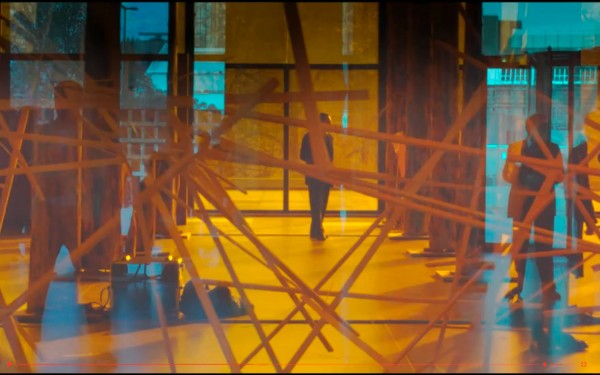
Reflections: Ein Film von SHIMURAbros
Reflections: Filmic impressions of the Festival of Future Nows at Neue Nationalgalerie, Staatliche Museen zu Berlin. A film by SHIMURAbros.
Reflections: Filmische Impressionen des Festival of Future Nows in der Neuen Nationalgalerie, Staatliche Museen zu Berlin. Ein Film von SHIMURAbros.
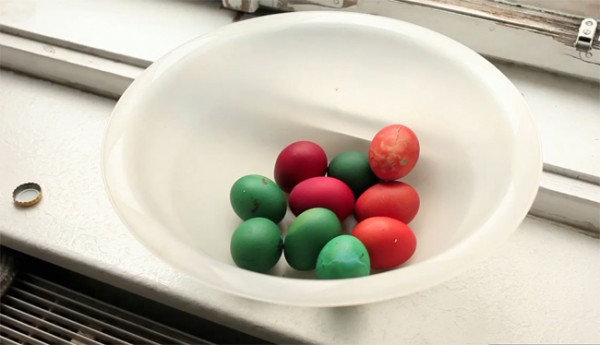
One flew east, One flew west: Ein Film von Yuichiro Tamura
One flew east, One flew west
A present recollection of moments of the 9th semester at the Institut für Raumexperimente seen through the lense of Tamura Yuichiro. A film by Tamura Yuichiro.
One flew east, One flew west
Ein Erinnerung an Momente des 9. Semesters am Institut für Raumexperimente aufgenommen von Tamura Yuichiro. Ein Film von Tamura Yuichiro.
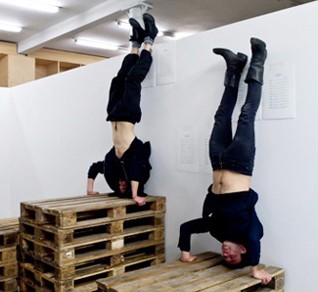
Movements Are Facts: Ein Film von Natascha Mendonca
Movements Are Facts: The past 5 years of the Institut für Raumexperimente seen through its archive footage. A film by Natasha Mendonca.
Movements Are Facts: Die vergangenen fünf Jahre des Institut für Raumexperimente durch filmisches Archivmaterial gesehen. Ein Film von Natasha Mendonca.
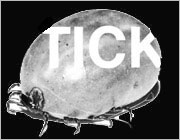
Tick Ausgabe 2/3
Issue 2/3 contains L-A-N-G-U-A-G-I-N-G with texts from Daniela Seel, Rike Scheffler, Sis Matthé, and Ernesto Estrella.
an experiment designed and edited by: Eric Ellingsen (heartheart)
TICK is curated by a rotating group of artists and writers from the Institut für Raumexperimente, UdK Berlin
http://raumexperimente.net/tickjournal/issue-2-3
Ausgabe 2/3 enthält L-A-N-G-U-A-G-I-N-G mit Texten von Daniela Seel, Rike Scheffler, Sis Matthé und Ernesto Estrella.
ein Experiment konzipiert von Eric Ellingsen (heartheart)
TICK wird von einer wechselnden Gruppe von Künstlern und Schreibenden des Instituts für Raumexperimente kuratiert.
http://raumexperimente.net/tickjournal/issue-2-3/
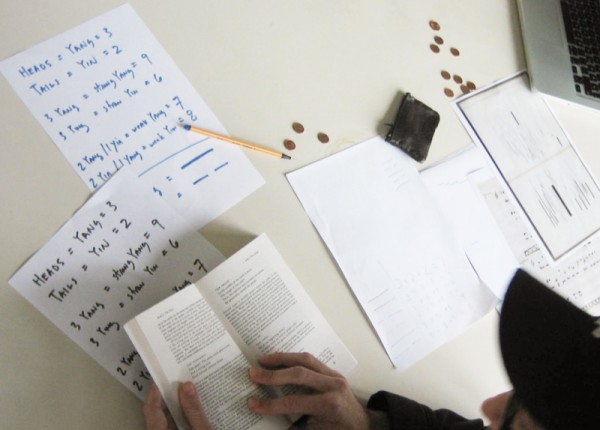
Reading Practice
Making Of: Reading PracticeCurated by Eric Ellingsen and Christina Werner
A text is suggested by a different participant each week and then that text is complimented with additional texts by the directors. Readings of the texts are done out loud by all the participants at the round table; recordings of authors, when available, are listened to, and everything is laced with discussions.
READING MATERIAL
Artmann, Hans Carl, „Acht-Punkte-Proklamation des poetischen Aktes“, in: Gerhard Rühm (Hrsg.): Die Wiener Gruppe. Achleitner, Artmann, Bayer, Rühm, Wiener. Texte, Gemeinschaftsarbeiten, Aktionen, Hamburg 1967, S. 9–10.
Ball, Hugo, “Dada Manifesto”, in: Dawn Ades, The Dada Reader: ACritical Anthology, Chicago 2006, o. S.
Bowlt, John E., A Splap in the Face of Public Taste: A Jubilee for David Burliuk and the Cause of Russian Futurism, Irvine 1986.
Duchamp Marcel u. a., Marcel Duchamp: Musical Erratum and in Conversation, Audio CD, LTM Recordings, North Elmham 2008.
Eliot, T. S., Burnt Norton, London 1941.
Folie, Sabine (Hrsg.), Un coup de dés, Aust.-Kat. Generali Foundation Wien, Köln 2008.
Gabo, Naum und Antoine Pevsner, Das Realistische Manifest, Berlin 1988.
Gertrude Stein, Picasso, Boston 1959.
Lightman,
Alan P., Einstein’s Dreams. A Novel, New York 1993.
Lissitzky, El, “Nasci”, in: Kurt Schwitter, Merzhefte, Faksimile-Nachdruck, Bern 1975, o. S.
Mac Low, Jackson, The Black Tarantula Crossword Gathas the 8-Voice Stereo-Canon Realization, Düsseldorf 1977.
Mallarmé, Stéphane, Un coup de dés , New York 1992.
Marinetti, F. T., „The Founding and Manifesto of Futurism“, in: Flint, R. W., Marinetti. Selected Writings, New York 1972, o. S.
Marinetti, F. T., La battaglia di Tripoli, Padua 1912.
Marinetti, F. T., „Dune, parole in libertà“, in: Luciano De Maria, Teoria e invenzione futurista, Mailand 1983, o. S.
Meyer, Hannes, “Bauen“, in: Martin Kieren u. a., Hannes Meyer, Architekt, 1889-1954. Schriften der zwanziger Jahre im Reprint: ABC, Das Bauhaus, Das Werk. Baden 1990, o. S.
Moholy-Nagy, László, “Dynamish-konstruktives Kraftsystem“, in: Der Sturm, 5. Dezember 1922, S. 186.
Moholy-Nagy, László, Vision in Motion, Chicago 1947, S. 11–12.
Moscow, A. Krutschonjch, “Figurinen, die plastische Gestaltung der elektro-mechanischen Schau „Sieg über die Sonne“ , in: El Lissitzky, Figurinen-Mappe, Hannover 1923.
Perec, Georges, „The Street“, in: Georges Perec und John Sturrock, Species of Space and Other Pieces, London 1997, S. 44–55.
Queneau, Raymond, Exercises in Style, New York 1981.
Rensch, Peter, Hugo Ball: Karawane, Berlin 1995.
Schwitters, Kurt, “Ur Sonata”, in: Jerome Rothenberg u. a., Poems, Performances Pieces, Proses, Plays, Poetics, Philadelphia 1993, o. S.
Taut, Bruno, “Down with Seriousism”, in: Ulrich Conrads, Programs and Manifestoes on 20th-Century Architecture, Cambridge 1971, o. S.
Wilhelm, Richard und Cary F. Baynes (Hrsg.), The I Ching; Or, Book of Changes, Princeton 1967.
Making Of: Reading PracticeKuratiert von Eric Ellingsen & Christina Werner
Jede Woche wird ein Text eines Teilnehmers vorgeschlagen und im Weiteren durch zusätzliche Texte seitens der Diskussionsleiter/in ergänzt. Die Texte werden laut am runden Tisch vorgelesen. Vorhandene Audio-Aufnahmen werden begleitend dazu angehört und durch Diskussionen ergänzt.
LITERATURAUSWAHL
Artmann, Hans Carl, „Acht-Punkte-Proklamation des poetischen Aktes“, in: Gerhard Rühm (Hrsg.): Die Wiener Gruppe. Achleitner, Artmann, Bayer, Rühm, Wiener. Texte, Gemeinschaftsarbeiten, Aktionen, Hamburg 1967, S. 9–10.
Ball, Hugo, “Dada Manifesto”, in: Dawn Ades, The Dada Reader: ACritical Anthology, Chicago 2006, o. S.
Bowlt, John E., A Splap in the Face of Public Taste: A Jubilee for David Burliuk and the Cause of Russian Futurism, Irvine 1986.
Duchamp Marcel u. a., Marcel Duchamp: Musical Erratum and in Conversation, Audio CD, LTM Recordings, North Elmham 2008.
Eliot, T. S., Burnt Norton, London 1941.
Folie, Sabine (Hrsg.), Un coup de dés, Aust.-Kat. Generali Foundation Wien, Köln 2008.
Gabo, Naum und Antoine Pevsner, Das Realistische Manifest, Berlin 1988.
Gertrude Stein, Picasso, Boston 1959.
Lightman,
Alan P., Einstein’s Dreams. A Novel, New York 1993.
Lissitzky, El, “Nasci”, in: Kurt Schwitter, Merzhefte, Faksimile-Nachdruck, Bern 1975, o. S.
Mac Low, Jackson, The Black Tarantula Crossword Gathas the 8-Voice Stereo-Canon Realization, Düsseldorf 1977.
Mallarmé, Stéphane, Un coup de dés , New York 1992.
Marinetti, F. T., „The Founding and Manifesto of Futurism“, in: Flint, R. W., Marinetti. Selected Writings, New York 1972, o. S.
Marinetti, F. T., La battaglia di Tripoli, Padua 1912.
Marinetti, F. T., „Dune, parole in libertà“, in: Luciano De Maria, Teoria e invenzione futurista, Mailand 1983, o. S.
Meyer, Hannes, “Bauen“, in: Martin Kieren u. a., Hannes Meyer, Architekt, 1889-1954. Schriften der zwanziger Jahre im Reprint: ABC, Das Bauhaus, Das Werk. Baden 1990, o. S.
Moholy-Nagy, László, “Dynamish-konstruktives Kraftsystem“, in: Der Sturm, 5. Dezember 1922, S. 186.
Moholy-Nagy, László, Vision in Motion, Chicago 1947, S. 11–12.
Moscow, A. Krutschonjch, “Figurinen, die plastische Gestaltung der elektro-mechanischen Schau „Sieg über die Sonne“ , in: El Lissitzky, Figurinen-Mappe, Hannover 1923.
Perec, Georges, „The Street“, in: Georges Perec und John Sturrock, Species of Space and Other Pieces, London 1997, S. 44–55.
Queneau, Raymond, Exercises in Style, New York 1981.
Rensch, Peter, Hugo Ball: Karawane, Berlin 1995.
Schwitters, Kurt, “Ur Sonata”, in: Jerome Rothenberg u. a., Poems, Performances Pieces, Proses, Plays, Poetics, Philadelphia 1993, o. S.
Taut, Bruno, “Down with Seriousism”, in: Ulrich Conrads, Programs and Manifestoes on 20th-Century Architecture, Cambridge 1971, o. S.
Wilhelm, Richard und Cary F. Baynes (Hrsg.), The I Ching; Or, Book of Changes, Princeton 1967.
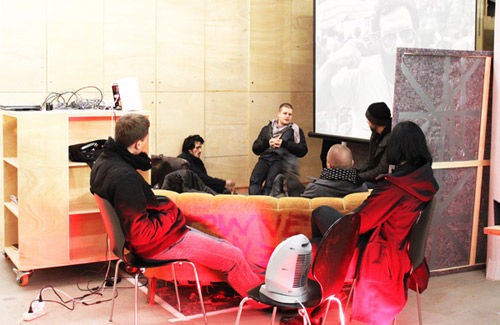
Film Practice
Making Of: Film Practice
Rather than watch the theatrical releases of films, we watch ‚making of‘ featurettes, typically found in the film’s bonus materials. Films are followed by discussions on the couches.
Winter Semester 2009/10
Curated by Eric Ellingsen & Christina Werner
Fernando Meirelles: „A Vision Of Blindness“ from Blindness, 2008
Jim Jarmusch: „The Odyssey: Journey Into the Life of a Samurai“ from Ghost Dog, 1999
Werner Herzog: Burden of Dreams, 1982
Stacy Peralta: Dogtown and Z-Boys, 2001
„Volume 1: The Work of Director Spike Jonze“ (Making of „Drop“ with The Pharcyde, Audio, commentaries from Fatboy Slim, Christopher Walken)
„Planet Earth part 1: behind-the-scenes footage“ by David Attenborough
Werner Herzog: Grizzly Man, 2005
Peter Watkins: Punishment Park, 1971
Wendy Apple: The Cutting Edge – The Magic of Movie Editing, 2004
Alfred Hitchcock: „Rope Unleashed“ featurette
Eleanor Coppola: Hearts of Darkness – A Filmmaker’s Apocalypse, 1991
Michel Gondry: Eternal Sunshine of The Spotless Mind, 2004: Making-of featurette
Ron Fricke: Baraka, 1992
Sofia Coppola: Lost in Translation, 2003: „Lost on Location“: behind-the-scenes featurette
Bill Moyers and Joseph Campbell: Joseph Campbell and the Power of Myth, 1988
Richard Feynman: The inconceivable nature of nature
Iannis Xenakis: Ligeti – Artikulation
Wim Wenders: Notebook on Cities and Clothes, 1989
Alison Chernick: Matthew Barney: No Restraint, 2006
Dusk to Dawn: Long Film Night Curated by: Eric Ellingsen and Christina Werner with Pash Buzari, 8 - 9 July 2010
List of Films:
Time perception videos (Youtube):
„La Sortie de l’Usine Lumière à Lyon“ (The first commercial movie, 1895); and „Vue Lumière No 765 – Loie Fuller’s Serpentine Dance“ (1896) by The Lumière Brothers
„Jean Taris, Swimming Champion“ (1931) by Jean Vigo
„Koyaanisqatsi: Life Out of Balance“ (scenes) & Bonus Features Interview with the
director and composer, by Godfrey Reggio, music by Phillip Glass
„Claim Excerpts“ (1971) by Vito Acconci
„Rhythm 10“ („The Star“, 1999); „Art Must Be Beautiful“ (1975);
and „Rhythm 0“ (1974), by Marina Abramovi?
„Zen for Film“ (1962-1964) by Nam June Paik
Two films by Pash Buzari
„Cinematographer Style“ (2006) by Jon Fauer
„For All Mankind“ (1989) by Al Reinert
„La Jetée“ (1962) by Chris Marker
„The Wild Blue Yonder“ (director’s commentary), by Werner Herzog
„The Blue Planet: Seas of Life“ (Episode 4: „The Deep“ 2001) by BBC & Discovery Channel
Making-of Documentary „Truffaut: A View from the Inside“ and „An Appreciation with Bob Balaban and Biographer Annette Insdorf“, both from the DVD for „Day for Night“ (1973) by Francois Truffaut
Making Of: Film Practice
Anstatt die Trailer der Filme anzuschauen, werden wir das „Making-of“ ansehen, welches in der Regel im Bonus Material des Filmes gefunden werden kann. Im Anschluss an die Filme finden Gespräche auf der Couch statt.
Wintersemester 2009/10
Kuratiert von: Eric Ellingsen & Christina Werner
„A Vision Of BLINDNESS“ von Fernando Meirelles, von „BLINDNESS“
„The Odyssey: Journey Into the Life of a Samurai“ von Jim Jarmusch, von „Ghostdog“
„Burden of Dreams“ von Werner Herzog
„Dog Town Z Boys“ von Stacy Peralta
„Volume 1: The Work of Director Spike Jonze“ (Making of „Drop“ mit The Pharcyde, Audio, Kommentär von Fatboy Slim, Christopher Walken)
„Planet Earth part 1: behind-the-scenes footage“ von David Attenborough
„Grizzly Man“ von Werner Herzog
„Punishment Park“ von Peter Watkins
„The Cutting Edge – The Magic of Movie Editing“ von Wendy Apple
„Rope Unleashed featurette“ von Alfred Hitchcock
„Hearts of Darkness – A Filmmaker’s Apocalypse“ von Eleanor Coppola
„Eternal Sunshine of The Spotless Mind: Making-of featurette“ von Michel Gondry
„Baraka“ von Ron Fricke
„Lost on Location: behind-the-scenes featurette of Lost in Translation“ von Sophia Coppola
„Joseph Campbell and the Power of Myth“ von Bill Moyers and Joseph Campbell
„Inconceivable nature of nature“ von Richard Feynman (Youtube)
„Ligeti – Artikulation“ von Iannis Xenaki (Youtube)
„Notebook on Cities and Clothes“ von Wim Wenders
„Matthew Barney No Restraint“ von Alison Chernick
Dusk to Dawn: Lange Filmnacht Kuratiert von Eric Ellingsen und Christina Werner mit Pash Buzari, 8. - 9. Juli 2010
Vorgestellte Filme:
Time perception videos (Youtube):
„La Sortie de l’Usine Lumière à Lyon“ (Der erste kommerzielle Film, 1895); und „Vue Lumière No 765 – Loie Fuller’s Serpentine Dance“ (1896) von The Lumière Brothers
„Jean Taris, Swimming Champion“ (1931) von Jean Vigo
„Koyaanisqatsi: Life Out of Balance“ (Szenen) & Bonus Features Interview mit dem Regisseur und Komponist, von Godfrey Reggio, Musik von Phillip Glass
„Claim Excerpts“ (1971) von Vito Acconci
„Rhythm 10“ („The Star“, 1999); „Art Must Be Beautiful“ (1975); und „Rhythm 0“ (1974), von Marina Abramovic
„Zen for Film“ (1962-1964) von Nam June Paik
Zwei Filme von Pash Buzari
„Cinematographer Style“ (2006) von Jon Fauer
„For All Mankind“ (1989) von Al Reinert
„La Jetée“ (1962) von Chris Marker
„The Wild Blue Yonder“ (Kommentar des Regisseurs), von Werner Herzog
„The Blue Planet: Seas of Life“ (Episode 4: „The Deep“ 2001) von BBC & Discovery Channel
Making-of Dokumentarfilme „Truffaut: A View from the Inside“ und „An Appreciation with Bob Balaban und Biographer Annette Insdorf“, von der DVD „Day for Night“ (1973) von Francois Truffaut

You Smell
Experience Experiments (You Smell)
3rd order connections & spatial temporal context of noses; odorama; smell-o-rama; WWII doctors and health; pheromones & the pits; sensory humunculus
Reading:
Gregory Bateson: Mind and Nature: Introduction
Diane Ackerman: A Natural History of the Senses: “Smell”
Thomas Worm: „More Than Just a Passionate Nose“ in Dufttunnel / Scent Tunnel
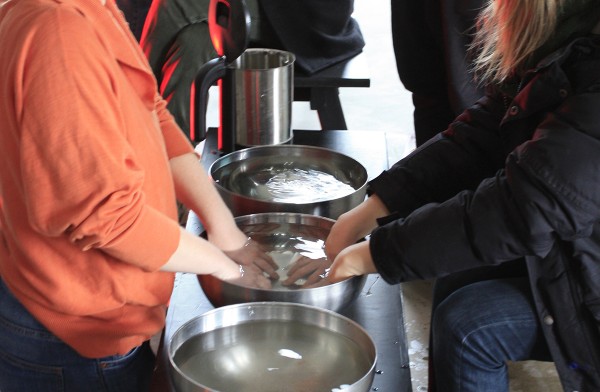
Sensible Movements
Experience Experiments (Sensible Movements)
“The is experience at ground level … It’s experience grasped at the level of the setting in which your body moves, the gestures it makes, all the ordinariness connected with your clothes, with food, with traveling, with your daily routine, with your space.” George Perec
Seeing what you’re feeling; Étienne-Jules Marey; experimental filters; control and choice; truth-to-nature, mechanical objectivity, trained judgment; center of movement; drips; snow-flakes; pick-pockets on tours with neuroscientists; calder’s circus’; personal space
Readings:
George Perec: Species of Spaces and Other Pieces: “The Work of Memory”
Gilles Deleuze & Felix Guattari: A Thousand Plateaus: “1730: Becoming-Intense, Becoming-Animal, Becoming-Imperceptible…”
Group experiment : Beckett, WATT walk & Chladni plates +

Seeing Things Double Again
Experience Experiments (Seeing Things Double Again)
Albers; Gestalt rules; visual intelligence; after images ; steoposis; blindspots; seeing illusions; constraints; inattentional blindness (Link: Visual Cognition Laboratory)
Readings:
V. S. Ramachandran: Phantoms in the Brain: “Do Martians See Red?”
Jonathan Crary: „Historical Readings on the Afterimage“ in Olafur Eliasson: your colour memory
Simon Ings: The Eye: A Natural History: “The Commonwealth of the Senses”
Look reading together: excerpts from Donald Hoffman: Visual Intelligence: How We Create What We See
Experiment: seeing into you blindspot walk
Video excerpts from Werner Herzog: Fata Morgana, 1971
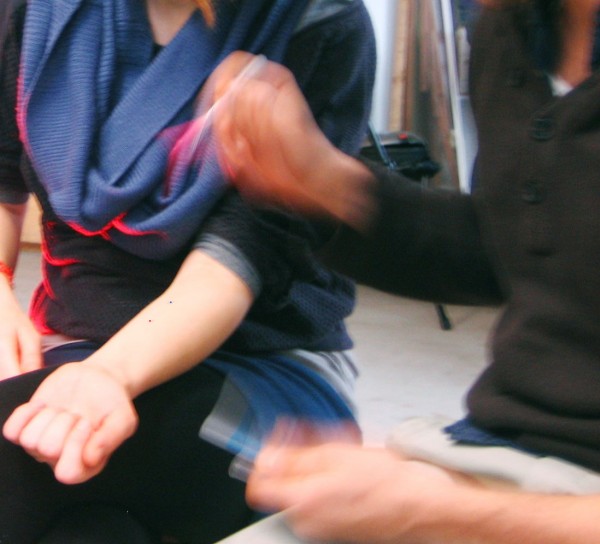
Feeling Emotional, How Touching
Experience Experiments (Feeling Emotional, How Touching)
Proprioception; sustained spatial accuracy; body schema & body image (precept, concept, affect); embodiment; fixed frames of reference; expression of emotions in man and animals; the Molyneux question; kiki/bouba effect; throwness
Readings:
Erin Manning and Brian Massumi: Coming Alive in a World of Texture: For Neurodiversity
Shaun Gallagher: How the Body Shapes the Mind (excerpts)
Recommendations:
Jules Verne: 20,000 Leagues Under the Sea
Ian Hacking: Representing and Intervening: “The Creation of Phenomena”
Table-top experiment (group): alien hand syndrome; inverted mirror hand tracing experiments; inverted expressions; von frey hairs
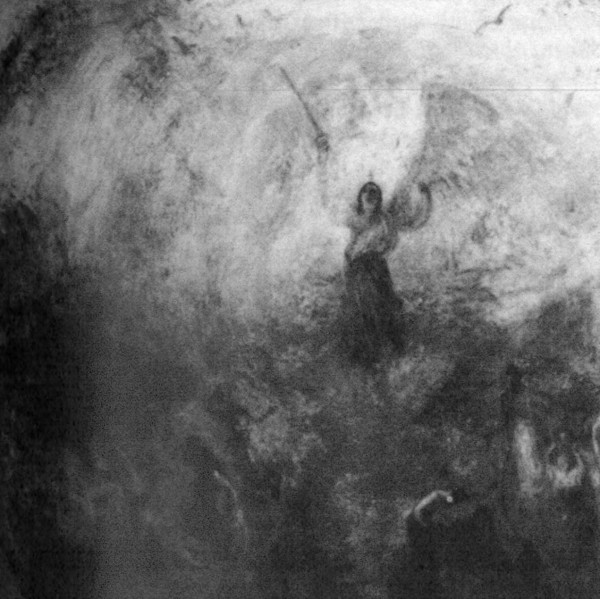
Seeing Things
Experience Experiments (Seeing Things)
You as a scientific instrument; ‘first perceptions’ experiments; consciousness; experience; interference; prisms; experimentum crucis; some enlightenment
Readings:
Johann Wolfgang von Goethe: “The Human Being is the Most Exact Instrument” & “Delicate Empiricism” in Goethe on Science
Richard Dawkins: Unweaving the Rainbow: „Bar Codes in the Stars“
Jonathan Crary: “Visionary Abstractions” in Surroundings Surrounded
Experiment: reenact Goethe
Watch: rotorelief films of Marcel Duchamp
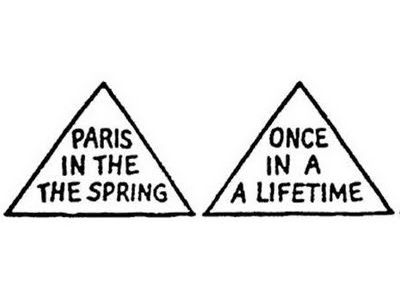
Your Sense of Timing
Experience Experiments (Your Sense of Timing)In preparation for Three Days of Making Time: Revisiting the Debate between Bergson and Einstein
Einstein Bergson debate; waterfall illusion; thought experiments; Laplace and irreversibility
Readings:
Henri Bergson: selections from Matter and Memory and Creative Evolution
Jorge Luis Borges: „The Garden of Forking Paths“
The Bergson/Einstein debate
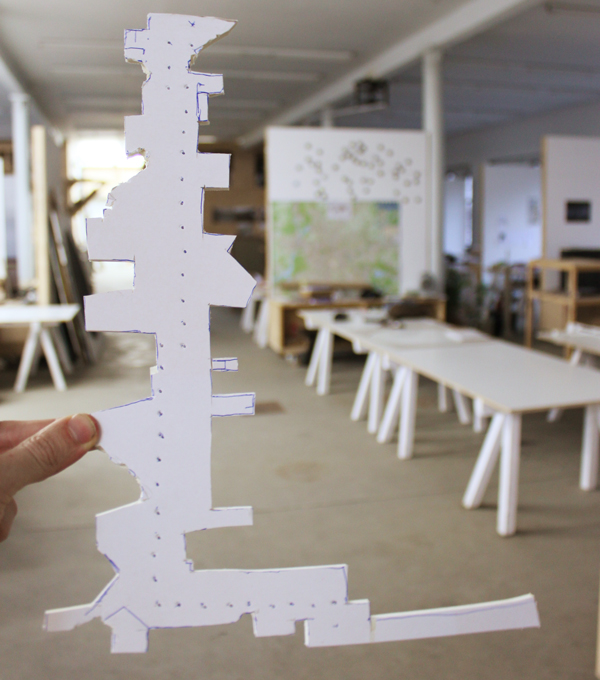
Feeling Your Way
Experience Experiments (Feeling Your Way)
Mapping; without a compass; measure; all the old ways about; you are the other too; agency of mapping; Fake-estates; non-sites; the map is not the territory; a dip in the lake; psychogeography ; Situationist International; geography & psychogeography; walk ways; Ian Sinclair; omnidirectional treadmills; haptic feedback; John Wylie: „A single day’s walking“
Readings:
Michael de Certeau: The Practice of Everyday Life: “Walking in the City”
Jorge Luis Borges: „On Exactitude in Science“
Robert Smithson: The Collected Writings: „A Provisional Theory of Non-Sites“
Group experiment: Berlin blind map experiment
Experience Experiments (Feeling Your Way)
Mapping; without a compass; measure; all the old ways about; you are the other too; agency of mapping; Fake-estates; non-sites; the map is not the territory; a dip in the lake; psychogeography ; Situationist International; geography & psychogeography; walk ways; Ian Sinclair; omnidirectional treadmills; haptic feedback; John Wylie: „A single day’s walking“
Readings:
Michael de Certeau: The Practice of Everyday Life: “Walking in the City”
Jorge Luis Borges: „On Exactitude in Science“
Robert Smithson: The Collected Writings: „A Provisional Theory of Non-Sites“
Group experiment: Berlin blind map experiment
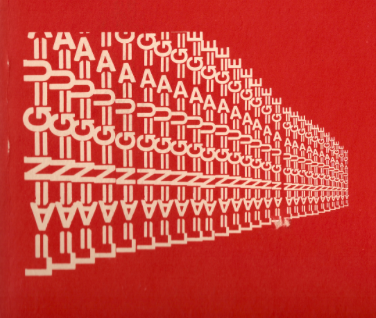
Poetry Experiments & The Artist’s Book
Experience Experiments (Poetry Experiments & The Artist’s Book)
L=A=N=G=U=A=G=E Book; Species of Spaces; Exercises of Style; 0-9; constraints and rules; artsy-fartsy
In class we will play around/make experiences in UbuWeb.
Readings:
L=A=N=G=U=A=G=E 1978 — 1981: Bernadette Mayer: “Experiments”
L=A=N=G=U=A=G=E 1978 — 1981: Bruce Andrews: “Text and Context”
Read together in class: Daniel Spoerri; An Anecdoted Topography of Chance; Vito Acconci
Experiment: Everybody picks one: Please spend some time before the class finding one video, poem, or recording on UbuWeb which you can play for the class.
Excursion to barbara wien bookstore/gallery & Fluxus (Dieter Roth) collection

Intuition, Jumping Around, and Other Methods
Experience Experiments (Intuition, Jumping Around, and Other Methods)
“The most lively thought is still inferior to the dullest sensation.” Hume, 1739
I. Morning
Empiricists; Frei Otto partners with matter; presuppositions; a role of theory; Doubt & Descartes; Epic Theater (Brecht’s rules of); double blind; Pepsi challenge; Tuskegee; MilgramExperiments; Sackett’s 56 biases; social psychology’s ‘will you go to bed with me’; mad scientists
Readings:
Gilles Deleuze: Bergsonism: „Intuition as Method“; „A Return to Bergson“
Michel Serres with Bruno Latour: Conversations on Science, Culture, and Time: “Method”
Erwin Schrodinger, What is Life?: “The Naïve Physicist’s Approach to the Subject”
Experiment: soap films
II. Afternoon
History of Nature lecture: Aristotle 4 causes, observation to experiment, Galileo, Bacon, Christopher Wren kills dogs, Linnaeus, Buffon, le Notre, Darwin, Smithson, Self-organization, far from equilibrium
Readings:
Raymond Williams: Keywords: A Vocabulary of Culture and Society
Daniel Botkin: Discordant Harmonies: “A View From a Marsh: Myths and Facts about Nature”, 3-13.
Bruno Latour: Introduction to We Have Never Been Modern
Experience Experiments (Intuition, Jumping Around, and Other Methods)
“The most lively thought is still inferior to the dullest sensation.” Hume, 1739
I. Morning
Empiricists; Frei Otto partners with matter; presuppositions; a role of theory; Doubt & Descartes; Epic Theater (Brecht’s rules of); double blind; Pepsi challenge; Tuskegee; MilgramExperiments; Sackett’s 56 biases; social psychology’s ‘will you go to bed with me’; mad scientists
Readings:
Gilles Deleuze: Bergsonism: „Intuition as Method“; „A Return to Bergson“
Michel Serres with Bruno Latour: Conversations on Science, Culture, and Time: “Method”
Erwin Schrodinger, What is Life?: “The Naïve Physicist’s Approach to the Subject”
Experiment: soap films
II. Afternoon
History of Nature lecture: Aristotle 4 causes, observation to experiment, Galileo, Bacon, Christopher Wren kills dogs, Linnaeus, Buffon, le Notre, Darwin, Smithson, Self-organization, far from equilibrium
Readings:
Raymond Williams: Keywords: A Vocabulary of Culture and Society
Daniel Botkin: Discordant Harmonies: “A View From a Marsh: Myths and Facts about Nature”, 3-13.
Bruno Latour: Introduction to We Have Never Been Modern
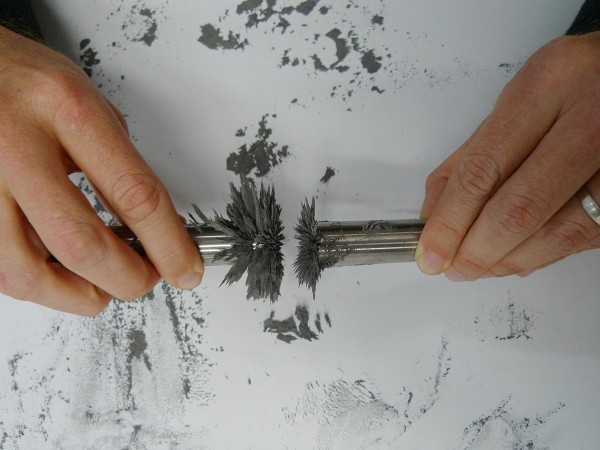
Making Experiments Experience
Experience Experiments (Making Experiments Experience)
Production of knowledge; what is an experiment: from observation to making; thinking doing; Hobbes boil’s at Boyle; if you can spray them they are real; ‘members account’, ‘strangers account’, and making a book about experiments; intervene in the world; creation of new phenomena; and how the ship gets in the bottle
Video to watch in class: Ant Farm: Inflatables, 1971
References for introduction:
Steven Shapin and Simon Schaffer: Leviathan and the Air-Pump
Peter Galison: How Experiments End
Ian Hacking: Representing and Intervening
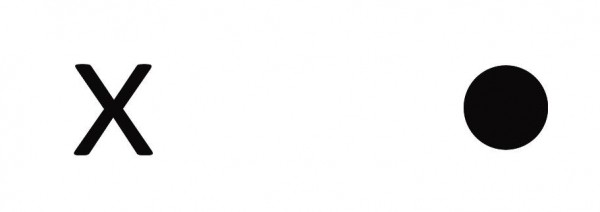
Experimente Erfahren
Experience Experiments (the making of) Curated by Eric Ellingsen & the Institut für Raumexperimente
“Experientia is rendered ‘experience’ and distinguished from ‘experimentum’ (experiment), though this distinction was not common in the period.”
– Note in Appendix to Simon Schaffer’s Latin translation of Thomas Hobbes’s Physical Dialogue (1661)
1) cover your left eye. (2) stare at the X. (3) move your head closer to the X until you see the spot disappear.
“The physicist George Darwin used to say that every once in a while one should do a completely crazy experiment, like blowing the trumpet to the tulips every morning for a month. Probably nothing would happen, but what if it did?”
– Ian Hacking, Representing and Intervening
“Experiments are elaborate filters set up in the space of phenomena.”
– Peter Galison, How Experiments End
“I do not know whether my way of approach is really the best and simplest. But, in short, it was mine. The ‘naïve physicist‘ was myself. And I could not find any better or clearer way towards the goal than my own crooked one… A good method of developing ‘the naïve physicist’s ideas’ is to start from the odd, almost ludicrous, question…”
– Erwin Schrodinger, What is Life?
Experiments are always experienced. Something happens. Maybe a + b starts to equal brightness. Maybe 2 + 2 = cold. Ideas follow feelings. Things touch, including ideas and precepts. We are enmeshed with time and space. Our perception of the world ripples through our curiosity, snags on our intellect, and collects our attention in intrigue, wonder, and questions. Why did that something happen and not something else? How can we make it happen again, or not happen again, differently, or the same? How can these things inform the art I make, precisely, critically? We start to experiment. How? Experimentation is a process and that process is never neatly waltzed steps between making and thinking. How to proceed? When does it end?
Isaac Newton sticks a long shoe maker’s needle, a bodkin, behind his eye-ball to squeeze and bend his lens in order to literally see how we see colors. But he also believes in Absolutes (absolute Time and Space), and the alchemical alignment of seven colors. How does what he wants to see affect how he is looking and his ability to see what is happening?
Experience Experiments asks by acting our simple questions: what are experiments, how are they made, how they are experienced, and how might experimental methods be important in the making of art?
In order to host such questions, we will organize the semester around our senses: seeing, hearing, smelling, touching, tasting, moving. We will treat the body as a scientific instrument, as Goethe says. Each sense of the body will have a rotation of ‘lectures’, ‘conversations’, ‘presentations.’ We will meet once a week, usually, but not always, on Wednesdays from 11-13.30. The entire course will cut a wavy track through a history of nature, science, art, writing, and perception. Each session will be like a state which shares many permeable boarders with the classes around it and simultaneously with the content of the Institut für Raumexperimente. Criticality and perception will underpin the entire course.
We will make many table-top experiments and a book. This will be a week to week book of questions which we add to and edit as we go along. Please email or bring questions about the readings or discussions each week which we will add into the book as content.
***Researchers at Charite in Steglitz have invited participants in this class to volunteer to take part in fMRI, EEG, and behavioral experiments. Please see me if you would like to volunteer.
***GUESTS: we will occasionally have guests joining us from the Max Planck Institute in Berlin
Experimente Erfahren : (the making of)Kuratiert von Eric Ellingsen & dem Institut für Raumexperimente
“Experiments are elaborate filters set up in the space of phenomena.”
– Peter Galison, How Experiments End
1) cover your left eye. (2) stare at the X. (3) move your head closer to the X until you see the spot disappear.
Experimente werden immer erfahren. Etwas passiert. Vielleicht reagieren a+b und erzeugen Helligkeit? Vielleicht gilt: 2 + 2 = kalt. Ideen folgen Gefühlen. Wir sind mit Zeit und Raum verwoben. Unsere Wahrnehmung der Welt mäandert getrieben durch unsere Neugier, stolpert über unseren Intellekt und konzentriert unsere Aufmerksamkeit in Faszination, Verwunderung und Fragen. Warum ist dies passiert, und nicht etwas anderes? Wie können wir dies wieder geschehen lassen, oder nicht geschehen lassen, anders, oder genauso? Wie können diese Dinge die Kunst, die ich mache, präzise und kritisch beeinflussen? Wir fangen an zu experimentieren. Wie? Experimentieren ist ein Prozess, und dieser Prozess besteht nie aus sauberen Tanzschritten zwischen Machen und Denken. Wie soll man also weiter verfahren?
Isaac Newton sticht eine lange Schuhmachernadel, einen bodkin, hinter seinen Augapfel, um Druck auf seine Linse auszuüben und sie zu verschieben, um buchstäblich zu sehen, wie wir Farben sehen. Aber er glaubt auch an das Absolute (absolute Zeit und absoluten Raum) und die alchemistische Ausrichtung von sieben Farben. Inwieweit beeinflusst, was er sehen will, wie er sieht und seine Fähigkeit, zu sehen was geschieht?
Experimente Erfahren fragt, indem es unsere einfachen Fragen ausführt: Was sind Experimente, wie werden sie gemacht, wie werden sie erfahren, und inwiefern könnten experimentelle Methoden in der Produktion von Kunst wichtig sein?
Um solche Fragen zu aktivieren, werden wir das Semester um unsere Sinne herum organisieren: Sehen, Hören, Riechen, Fühlen, Schmecken, Bewegen. Wir behandeln den Körper als ein wissenschaftliches Instrument, wie Goethe sagt. Im wöchentlichen Wechsel werden jedem Sinn „Vorträge“, „Unterhaltungen“ und „Präsentationen“ gewidmet. Wir werden uns einmal pro Woche treffen, gewöhnlich (aber nicht immer) mittwochs von 11.00-13:30 Uhr. Der gesamte Kurs wird sich einen kurvenreichen Verlauf durch eine Geschichte der Naturdarstellung, Wissenschaft, Kunst, des Schreibens und der Wahrnehmung bahnen. Jedes Treffen wird einem Areal gleichen, das viele durchlässige Grenzen zu anderen benachbarten Workshops und mit den Inhalten des Instituts für Raumexperimente aufweist. Kritikalität und Wahrnehmung werden den gesamten Kurs untermauern. Wir werden viele Übungsexperimente durchführen und ein Publikation produzieren. Dieser Kurs verlangt einen gewissen Zeitaufwand, der sich aber lohnt.
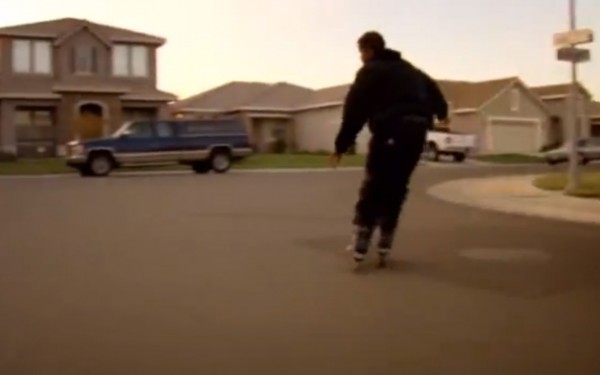
Introduction
Syllabus GrowingStarting from what you can’t stop thinking about. Choreographed by Eric Ellingsen
Herald Gatty, diagram from Finding your way without map or compass; sketch from Darwin’s 1837 notebooks.
This is the syllabus of the class.
(1) Ask one or two different participants each week to show things that really matter to them. Pick things that can be watched, read, and listened to together. Try to put the things into the space so they can be experienced together in some way.
(2) Ask everyone in the class to start building associations between things.
(3) Take notes on the associations.
(4) Generate conversations in the associations while talking about not only what is shown but why the associations seem relevant.
(5) During each class ask, what are we really talking about here? How does what we are talking about touch the world, connect to our work, why we feel we are here, what we are trying to learn and do?
We start each class from the things we cannot stop thinking about. From ignorant schoolmasters. By not starting with a prefixed syllabus but rather a way of syllabusing. From co-produced knowledge. Reach space is the zone in which a tide grows and recedes. The robust ecology of things that overlap. Living systems like like the messy edges of overlapping things. The idea of overlaps as a class space. To choreograph as a form of teaching. A learning space. To grow a form from content which resonates starting from the participants. To believe content is how things are linked and felt, not merely the things themselves. The things are also important. To know that knowledge is constructed by doing and then doing and then doing again. To build the tool of linking like and unlike things. Together over and over by linking like and unlike things together over and over. To rhythm by rhythming. Of seemingly disparate threads. To structure a control of letting go.
One of the ideas is to construct a critical confidence that connections can be made in the spontaneous listening in the room. That all listening also lists, sways, swerves. One of the ideas is to translate ideas and being critical into a tool for a practice. One of the ideas is to start experimenting with on-line formats for courses. (Not just to record lectures and listen to people talking somewhere else which say join.) One of the ideas is that we can experience something and reflect on the experience at the same time. One of the ideas is to generate an awareness of the systems which inform and condition and constrain the things seen. One of the ideas is that the ideas can change.
Each of the weeks is followed by suggestions to watch, read, listen. These are the weeks that we are growing. These suggestions are here merely to provide a collection of starting stones around which anyone can construct their own classes from the energy and interests and particular ecologies of the people sitting in a room different than the room we are now in.
These links and little readings came up during or came after.
You make the connections.
Readings:
Russell Crotty: The Universe from My Backyard
Juliana Spahr: This Connection of Everyone With Lungs
We started the first week seing Blindsight. This was from:
Youtube: Ramachandran on blind-sight
Youtube: The Boy Who Sees without Eyes
Link: Blindsight the movie
PDF: Ranciere, The Ignorant Schoolmaster
Syllabus GrowingStarting from what you can’t stop thinking about. Choreographed by Eric Ellingsen
Herald Gatty, diagram from Finding your way without map or compass; sketch from Darwin’s 1837 notebooks.
This is the syllabus of the class.
(1) Ask one or two different participants each week to show things that really matter to them. Pick things that can be watched, read, and listened to together. Try to put the things into the space so they can be experienced together in some way.
(2) Ask everyone in the class to start building associations between things.
(3) Take notes on the associations.
(4) Generate conversations in the associations while talking about not only what is shown but why the associations seem relevant.
(5) During each class ask, what are we really talking about here? How does what we are talking about touch the world, connect to our work, why we feel we are here, what we are trying to learn and do?
We start each class from the things we cannot stop thinking about. From ignorant schoolmasters. By not starting with a prefixed syllabus but rather a way of syllabusing. From co-produced knowledge. Reach space is the zone in which a tide grows and recedes. The robust ecology of things that overlap. Living systems like like the messy edges of overlapping things. The idea of overlaps as a class space. To choreograph as a form of teaching. A learning space. To grow a form from content which resonates starting from the participants. To believe content is how things are linked and felt, not merely the things themselves. The things are also important. To know that knowledge is constructed by doing and then doing and then doing again. To build the tool of linking like and unlike things. Together over and over by linking like and unlike things together over and over. To rhythm by rhythming. Of seemingly disparate threads. To structure a control of letting go.
One of the ideas is to construct a critical confidence that connections can be made in the spontaneous listening in the room. That all listening also lists, sways, swerves. One of the ideas is to translate ideas and being critical into a tool for a practice. One of the ideas is to start experimenting with on-line formats for courses. (Not just to record lectures and listen to people talking somewhere else which say join.) One of the ideas is that we can experience something and reflect on the experience at the same time. One of the ideas is to generate an awareness of the systems which inform and condition and constrain the things seen. One of the ideas is that the ideas can change.
Each of the weeks is followed by suggestions to watch, read, listen. These are the weeks that we are growing. These suggestions are here merely to provide a collection of starting stones around which anyone can construct their own classes from the energy and interests and particular ecologies of the people sitting in a room different than the room we are now in.
These links and little readings came up during or came after.
You make the connections.
Readings:
Russell Crotty: The Universe from My Backyard
Juliana Spahr: This Connection of Everyone With Lungs
We started the first week seing Blindsight. This was from:
Youtube: Ramachandran on blind-sight
Youtube: The Boy Who Sees without Eyes
Link: Blindsight the movie
PDF: Ranciere, The Ignorant Schoolmaster
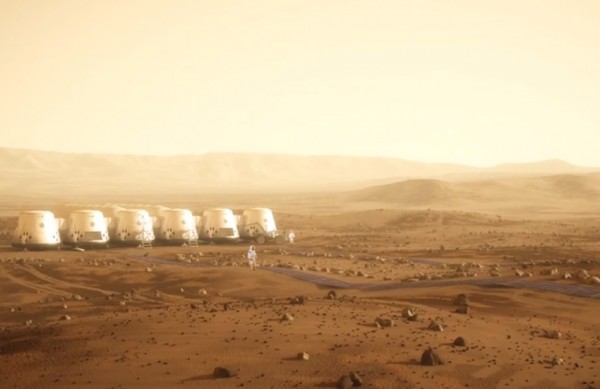
Syllabus Growing
Syllabus GrowingStarting from what you can’t stop thinking about. Choreographed by Eric Ellingsen
Herald Gatty, diagram from Finding your way without map or compass; sketch from Darwin’s 1837 notebooks.
This is the syllabus of the class.
(1) Ask one or two different participants each week to show things that really matter to them. Pick things that can be watched, read, and listened to together. Try to put the things into the space so they can be experienced together in some way.
(2) Ask everyone in the class to start building associations between things.
(3) Take notes on the associations.
(4) Generate conversations in the associations while talking about not only what is shown but why the associations seem relevant.
(5) During each class ask, what are we really talking about here? How does what we are talking about touch the world, connect to our work, why we feel we are here, what we are trying to learn and do?
We start each class from the things we cannot stop thinking about. From ignorant schoolmasters. By not starting with a prefixed syllabus but rather a way of syllabusing. From co-produced knowledge. Reach space is the zone in which a tide grows and recedes. The robust ecology of things that overlap. Living systems like like the messy edges of overlapping things. The idea of overlaps as a class space. To choreograph as a form of teaching. A learning space. To grow a form from content which resonates starting from the participants. To believe content is how things are linked and felt, not merely the things themselves. The things are also important. To know that knowledge is constructed by doing and then doing and then doing again. To build the tool of linking like and unlike things. Together over and over by linking like and unlike things together over and over. To rhythm by rhythming. Of seemingly disparate threads. To structure a control of letting go.
One of the ideas is to construct a critical confidence that connections can be made in the spontaneous listening in the room. That all listening also lists, sways, swerves. One of the ideas is to translate ideas and being critical into a tool for a practice. One of the ideas is to start experimenting with on-line formats for courses. (Not just to record lectures and listen to people talking somewhere else which say join.) One of the ideas is that we can experience something and reflect on the experience at the same time. One of the ideas is to generate an awareness of the systems which inform and condition and constrain the things seen. One of the ideas is that the ideas can change.
Each of the weeks is followed by suggestions to watch, read, listen. These are the weeks that we are growing. These suggestions are here merely to provide a collection of starting stones around which anyone can construct their own classes from the energy and interests and particular ecologies of the people sitting in a room different than the room we are now in.
These links and little readings came up during or came after.
You make the connections.
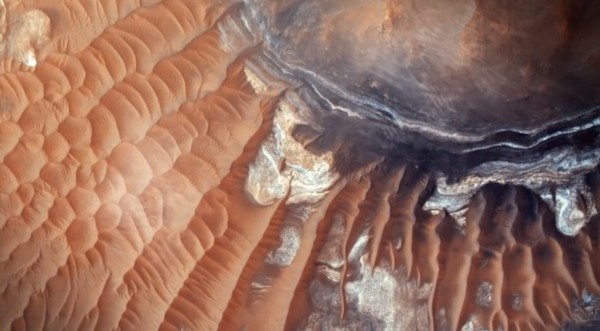
Syllabus Growing: Week 4
Week 4: This Hand is Up River, This Hand is Down River; There Are No Words for Pastled by Hendrik Wolking, then built into
This week’s syllabus starts from two examples of social organizations: (1) the possibility of living on a colony on Mars without the possibility of returning, (2) a linguist who lives with the Piraha and returns with different ideas of language and repetition and repetition and the tangled relationshiping between language, space, and time. Can we understand things we don’t have words for? What if you can’t talk for ten days? A meditation. Spatio- politico systems are discussed. Theories of first societies. How Iceland does it. Beware the snakes while sleeping. Should we butcher the ones who return from the sun squealing on the shadow casters in the cave? Please make your own links. If counting on anything maybe the difference between ordinal and cardinal counting systems counts? What if you live on Jupiter and there is only one day of sun a year and then you are locked in a closet for that one day? Is a closet also a cave dwelling? Who makes the social rules for your first society and how spatial are they? Please read the simulation intro. The relationship between organization of living and the politics of space are discussed, the possibility of leaving arriving, of staying in touch. How would you describe your sense of humor? See you on the moon.
(1) Please apply here to live on mars
(2) ALL SUMMER IN A DAY, Ray Bradbury :
„Ready?“ „Ready.“ „Now ?“ „Soon.“ (PDF)
(3) shhhhh; VIPASSANA MEDITATION
(4) Iceland’s ALTHING, DINGPOLITIKS, and MAKING THINGS PUBLIC, p-14-21 (PDF: Bruno Latour: How to Make Things Public)
(5) Daniel Evertt: recursion and languages without words for the past (Youtube: Das glücklichste Volk der Welt) (Daniel Everett: Endangered Languages and Lost Knowledge)
„Don’t sleep there are snakes“
(6) THE ALLEGORY OF THE CAVE, Plato
(7) Difference between ONE, TWO, THREE, and FIRST, SECOND, THIRD (Ordinal vs. Cardinal counting systems in Deleuze)
(8) Simulation and Simulacra, Jean Baudrillard, (read introduction)
(9) LOVE (2011 film), on the preservation of stories & a music album as a film (also watch the making of in bonus features)
(10) WOOL ( alternatives to systems around you & living in strange spaces)
(11) THE FIRST SOCIETIES, Rousseau, from The Social Contract
(12) Don’t miss your chance to buy moon-estate
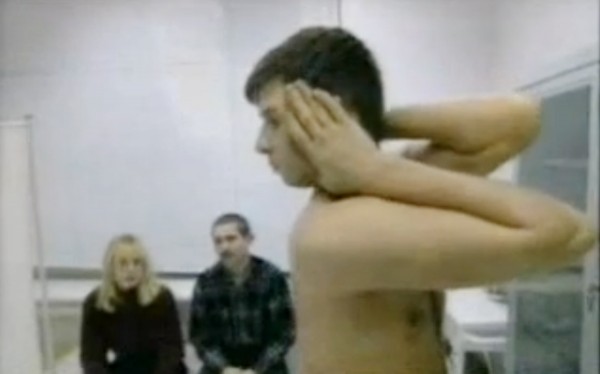
Syllabus Growing: Week 2
Week 2: REALOMETERSLed by Eric Ellingsen
Nikolai Maximenko: map showing the five gyres of the ocean
How do translations work? What are you carrying. To carry something across. The roots of translation are what? What eyes look like. How do we see the things (systems) that watch, seeing what’s inside of the eye while looking out. So looking in. Your street views spied on me. Some eyes are not dotted. To see your own perceptual bubble look straight ahead, put your arms to your side, see the place your hands disappear. Your peripheral views are lines of sight. One line is a poem. Rotate your poem by rotating your arms. Your cone is a bubble. Your bubble is more an ellipsoid really. What are the realometers which we use to gauge the world outside our bubbles? The instruments by which we perceive what is real. Are we. The things by which we touch the world. Like Olafur Eliasson says about hinges connecting art to the world through touch. To have touch. Like how Ray Bradbury says about touching over and over in Fahrenheit 451, for example: The difference between the man who just cuts lawns and a real gardener is in the touching. For example: The good writers touch life often. The mediocre ones run a quick hand over her. The bad ones rape her and leave her for the flies. In Reader’s Block, Walter Abish says make An act which would obliterate the conditions of the options. Let’s wonder what this means. Let’s wonder why we float shit everywhere like ocean gyres. What is the etymology of fucked? Let’s wonder about the rights of things. About precision. Let the glissando effect us. Let’s be the Vibrant Matters we think. Let’s wonder about pink crickets (we will do this the week after I think). Let’s try reading the shortest poem by Kurt Schwitters: W. Let’s wonder about sociolinguists who study the R.
(1) REALOMETERS:
“realometer.” Thoreau’s realometer would allow an inquiring person to measure the reality of his perceptions, to push past the “mud and slush of opinion, and prejudice, and tradition, and delusion, and appearance … to a hard bottom.” — from Walden
(2) STREET VIEWS (Article, nytimes.com)
(3) SOUND ILLUSIONS: (Youtube: Sound Illusion) (Youtube: The McGurk Effect, BBC)
(4) CONSTRUCTING KNOWLEDGE : Piaget on this
(5) FLOATERS in your eyes while looking at the CONTRAIL out there
(6) + a lawsuit over Woody Allen’s use of William Faulkner’s famous quote:
‚The past is never dead. The past is not even past.‘ (Article link, cnn.com)
(7) ALL THE BIBLE I REMEMBER, OF EMMA KAY and: (Article link, Frieze.com) (Image, boxc.net)
(8) FASTING: (People named after places: Indiana Jones x32)
(9) SONGLINES : documentary on aboriginal songs used in mapping and moving geographies: (Link: dl.nfsa.gov.au) (quick intro to the documentary; then full documentary)
(10) SOUND POETRY, elementalism, and breaking things into small parts
(11) HEARING THINGS and PHANTOM WORDS: (Youtube: Misheard Song Lyrics) (Website: Diana Deutsch) (Vimeo: HEARING THINGS)
(12) AGAINST EXPRESSION (PDF)
(13) EVERYTHING EXHAUSTING; Perec and : (great great blog by the way) (Lili Huang: An Exhausting Attempt of Reviewing Perec’s An Attempt at Exhausting a Place in Paris)
(14) FLYING BACKWARDS
(15) FISH MADE OF GARBAGE
(16) TURNING HEAD AROUND / seeing is past us (according to Dante)
—
READING examples from:
Bergson, Matter and Memory, p. 66-68, on now memory
Eileen Myles, “The Universe in my Backyard”, from The Importance of Being Iceland
Octavio Paz, The Labyrinth of Solitude, p.74-77, on translation and what one word can mean
Jackson McLow, Representative Works, “Jail Break”
Juliana Spahr, this connection of everything with lungs, intro
Diana Ackerman, A Natural History of the Senses, “etymology of FUCK”
Cecilia Vicuna, Spit Temple, intro and p.278
Craig Dworkin, Against Expression
Week 2: REALOMETERSLed by Eric Ellingsen
Nikolai Maximenko: map showing the five gyres of the ocean
How do translations work? What are you carrying. To carry something across. The roots of translation are what? What eyes look like. How do we see the things (systems) that watch, seeing what’s inside of the eye while looking out. So looking in. Your street views spied on me. Some eyes are not dotted. To see your own perceptual bubble look straight ahead, put your arms to your side, see the place your hands disappear. Your peripheral views are lines of sight. One line is a poem. Rotate your poem by rotating your arms. Your cone is a bubble. Your bubble is more an ellipsoid really. What are the realometers which we use to gauge the world outside our bubbles? The instruments by which we perceive what is real. Are we. The things by which we touch the world. Like Olafur Eliasson says about hinges connecting art to the world through touch. To have touch. Like how Ray Bradbury says about touching over and over in Fahrenheit 451, for example: The difference between the man who just cuts lawns and a real gardener is in the touching. For example: The good writers touch life often. The mediocre ones run a quick hand over her. The bad ones rape her and leave her for the flies. In Reader’s Block, Walter Abish says make An act which would obliterate the conditions of the options. Let’s wonder what this means. Let’s wonder why we float shit everywhere like ocean gyres. What is the etymology of fucked? Let’s wonder about the rights of things. About precision. Let the glissando effect us. Let’s be the Vibrant Matters we think. Let’s wonder about pink crickets (we will do this the week after I think). Let’s try reading the shortest poem by Kurt Schwitters: W. Let’s wonder about sociolinguists who study the R.
(1) REALOMETERS:
“realometer.” Thoreau’s realometer would allow an inquiring person to measure the reality of his perceptions, to push past the “mud and slush of opinion, and prejudice, and tradition, and delusion, and appearance … to a hard bottom.” — from Walden
(2) STREET VIEWS (Article, nytimes.com)
(3) SOUND ILLUSIONS: (Youtube: Sound Illusion) (Youtube: The McGurk Effect, BBC)
(4) CONSTRUCTING KNOWLEDGE : Piaget on this
(5) FLOATERS in your eyes while looking at the CONTRAIL out there
(6) + a lawsuit over Woody Allen’s use of William Faulkner’s famous quote:
‚The past is never dead. The past is not even past.‘ (Article link, cnn.com)
(7) ALL THE BIBLE I REMEMBER, OF EMMA KAY and: (Article link, Frieze.com) (Image, boxc.net)
(8) FASTING: (People named after places: Indiana Jones x32)
(9) SONGLINES : documentary on aboriginal songs used in mapping and moving geographies: (Link: dl.nfsa.gov.au) (quick intro to the documentary; then full documentary)
(10) SOUND POETRY, elementalism, and breaking things into small parts
(11) HEARING THINGS and PHANTOM WORDS: (Youtube: Misheard Song Lyrics) (Website: Diana Deutsch) (Vimeo: HEARING THINGS)
(12) AGAINST EXPRESSION (PDF)
(13) EVERYTHING EXHAUSTING; Perec and : (great great blog by the way) (Lili Huang: An Exhausting Attempt of Reviewing Perec’s An Attempt at Exhausting a Place in Paris)
(14) FLYING BACKWARDS
(15) FISH MADE OF GARBAGE
(16) TURNING HEAD AROUND / seeing is past us (according to Dante)
—
READING examples from:
Bergson, Matter and Memory, p. 66-68, on now memory
Eileen Myles, “The Universe in my Backyard”, from The Importance of Being Iceland
Octavio Paz, The Labyrinth of Solitude, p.74-77, on translation and what one word can mean
Jackson McLow, Representative Works, “Jail Break”
Juliana Spahr, this connection of everything with lungs, intro
Diana Ackerman, A Natural History of the Senses, “etymology of FUCK”
Cecilia Vicuna, Spit Temple, intro and p.278
Craig Dworkin, Against Expression
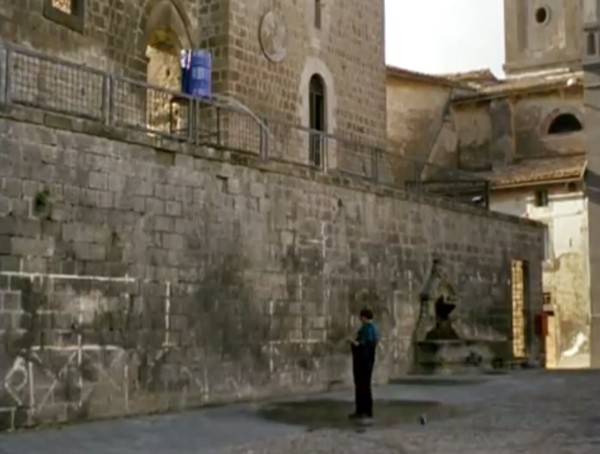
Syllabus Growing: Week 3
Week 3: TIMINGLed by Tamura Yuichiro
We start with a film by the artist called FOLLOW. FOLLOW is a film in which the artist follows a monk through the same tight, long circuit of a city each day. The monk is collecting food. Donations. Daily bread. The artist shows this because he is interested in time, rhythms, rhythms, repetition. About coming back to a finished project. About comparing his piece about walking to other walks he has done. We look at works by James Bennig. At other artist’s walks. We build our daily syllabus talking about slowing down by slowing things down. We talk of rituals and dailyness, how slowing down things helps us see things differently. And speeding up. About timing. About seeing time. The times we live in. About takes. About pink crickets. The German Amazon. (Doreen Massey says to keep your eye on Amazon. The Amazon is dirty.) Below there are links to the materiality of knowledge. Bergson’s thoughts on microbes seeing across the universe. About the things the times require us to do or not. The negotiations of such. How in the public hides the personal out in the open when things go fast. When things go to fast maybe we can’t feel them. We talked a little of today’s times. What the US looks like from Germany. What Germany looks like from Tokyo. The time to stop being cynical. How old children need to get guns given to them. If the systems around us hide in the flattened space of saying things like they are outdated. How to make transparent the space in which we live all our different stories. About interruptions and hiding in the flow. The thread of the world.
These links and little readings came up or came after.
You make the connections.
(1) WALKING CLIP: from Synecdoche, New York
(2) Roman Singer, „chairs“ (Trailer, link 1) (Trailer, link 2)
(3) AMAZON NAZI (Article, independent.co.uk) (Article, dailymail.co.uk)
(4) The Pink Cricket (Article, nytimes.com) (Link, crickett.com) (Article, slate.com)
(5) Lana Wachowski, the materially of knowledge
(5) James Benning: 10 Skies ; 13 lakes ; 20 cigarettes ; RR
(6) Zabriskie Point
(6) Rimini Protokoll: REMOTE X
(7) Alan Rickman
(8) Étienne-Jules Marey: Main, Ouverture et Fermeture.
(9) TIME to stop being cynical? Difference between sarcasm, humor and being cynical.
(10) Sharon Lockhart: Lunch Break (Vimeo: Double Tide) (Youtube: Lunch Break) (Link, e-flux) (Article link)
(11) Bergson and Einstein – Microbes seeing space time (PDF: Einstein, Bergson, and the Experiment that Failed: Intellectual Cooperation at the League of Nations) (PDF: Henri Bergson, Albert Einstein, and Henri Piéron: Remarks Concerning Relativity Theory)
(12) Bombs and the Rapidtronic (Youtube: How to Photograph an Atomic Bomb) (Youtube: Slow Motion Atomic Bomb)
(13) 3 SLOW FILMS:
“To be oriented in the relevant sense is not just to be here or there, in front of, behind, or to the right or left of something, but to be guided by ‘the thread of the world.’” Carman, Taylor, Merleau-Ponty (PDF: The Vestibular in Film: Orientation and Balance in Gus Van Sant’s Cinema of Walking)
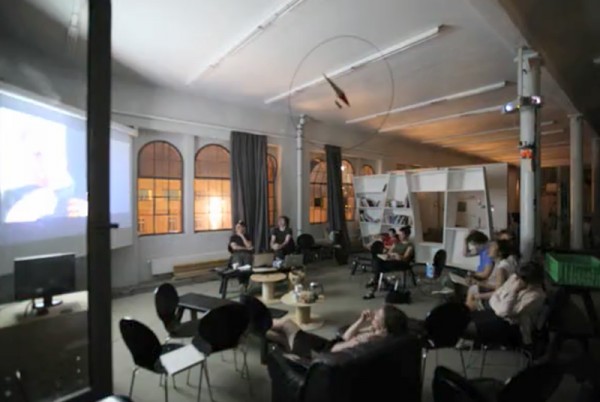
Dusk to dawn: Lange Filmnacht mit Pash Buzari
Dusk to dawnLong film night with Pash Buzari, Eric Ellingsen & Christina Werner
Time perception experiments:
„La Sortie de l’Usine Lumière à Lyon“ (The first commercial movie, 1895); and „Vue Lumière No 765 – Loie Fuller’s Serpentine Dance“ (1896) by The Lumière Brothers
„Jean Taris, Swimming Champion“ (1931) by Jean Vigo
„Koyaanisqatsi: Life Out of Balance“ (scenes) & Bonus Features Interview with the director and composer, by Godfrey Reggio, music by Phillip Glass
„Claim Excerpts“ (1971) by Vito Acconci
„Rhythm 10“ („The Star“, 1999); „Art Must Be Beautiful“ (1975); and „Rhythm 0“ (1974), by Marina Abramovic
„Zen for Film“ (1962-1964) by Nam June Paik
Two films by Pash Buzari
„Cinematographer Style“ (2006) by Jon Fauer
„For All Mankind“ (1989) by Al Reinert
„La Jetée“ (1962) by Chris Marker
„The Wild Blue Yonder“ (director’s commentary), by Werner Herzog
„The Blue Planet: Seas of Life“ (Episode 4: „The Deep“ 2001) by BBC & Discovery Channel
Making-of Documentary „Truffaut: A View from the Inside“ and „An Appreciation with Bob Balaban and Biographer Annette Insdorf“, both from the DVD for „Day for Night“ (1973) by Francois Truffaut
Research and Skype interview with Jonathan Fox
Dusk to dawnLange Filmnacht mit Pash Buzari, Eric Ellingsen & Christina Werner
Vorgestellte Filme:
„La Sortie de l’Usine Lumière à Lyon“ (Der erste kommerzielle Film, 1895); und „Vue Lumière No 765 – Loie Fuller’s Serpentine Dance“ (1896) von The Lumière Brothers
„Jean Taris, Swimming Champion“ (1931) von Jean Vigo
„Koyaanisqatsi: Life Out of Balance“ (Szenen) & Bonus Features Interview mit dem Regisseur und Komponist, von Godfrey Reggio, Musik von Phillip Glass
„Claim Excerpts“ (1971) von Vito Acconci
„Rhythm 10″ („The Star“, 1999); „Art Must Be Beautiful“ (1975); und „Rhythm 0“ (1974),
von Marina Abramovic
„Zen for Film“ (1962-1964) von Nam June Paik
Zwei Filme von Pash Buzari
„Cinematographer Style“ (2006) von Jon Fauer
„For All Mankind“ (1989) von Al Reinert
„La Jetée“ (1962) von Chris Marker
„The Wild Blue Yonder“ (Kommentar des Regisseurs), von Werner Herzog
„The Blue Planet: Seas of Life“ (Episode 4: „The Deep“ 2001) von BBC & Discovery Channel
Making-of Dokumentarfilme „Truffaut: A View from the Inside“ und „An Appreciation with Bob Balaban und Biographer Annette Insdorf“, von der DVD „Day for Night“ (1973) von Francois Truffaut
Research und Skype-Interview mit Jonathan Fox
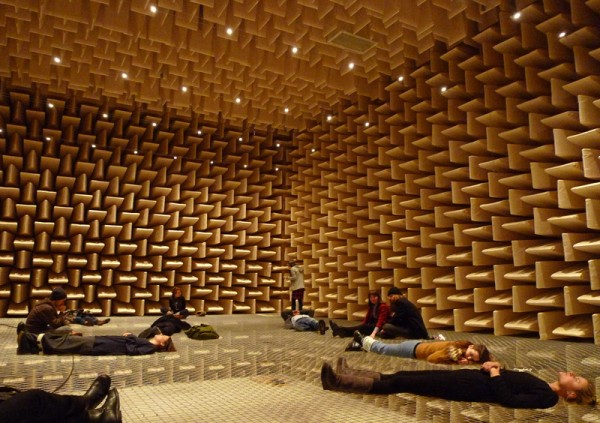
Experience Experiments: Akustische Räume
Experience Experiments: Hearing Things
Phantom words & sound experiments (by Diana Deutsch); Louise Lawler – Bird Calls; Steve Reich; Cymatics ; „Drip Music“; Cage “water walk”; William Labov, socio linguists in American malls (where is the laboratory); qualia
Reading:
Does Your Language Shape How You Think?, Guy Deutscher (Article link, New York Times)
Sleights of Mind, George Johnson (Article link, New York Times)
Experiment: (Website link, Diana Deutsch)
Visit to acoustic rooms: Institut für Strömungsmechanik und Technische Akustik with Eric Ellingsen
Experience Experiments: Akustische RäumeBesuch des Akustikraums im Institut für Strömungsmechanik und Technische Akustik mit Eric Ellingsen
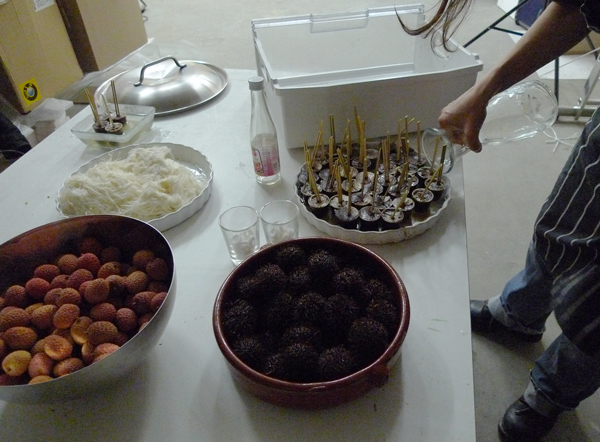
Experience Experiments: Abendessen im Dunkeln
Experience Experiments: Tasting the DarkWith Lynn Peemoeller, Lauren Maurer & Eric Ellingsen
Group experiment: just back from break, we will spend this class together in total darkness. We will all eat together and serve each other in a completely dark room, as well as hold our conversation.
Readings:
Diane Ackerman: A Natural History of the Senses: “Taste”
José Saramago: Blindness
Franz Kafka: A Hunger Artist
View programme PDF
Experience Experiments: Abendessen im Dunkeln (Geschmack von Dunkelheit)Mit Lynn Peemoeller, Lauren Maurer & Eric Ellingsen
Programm PDF
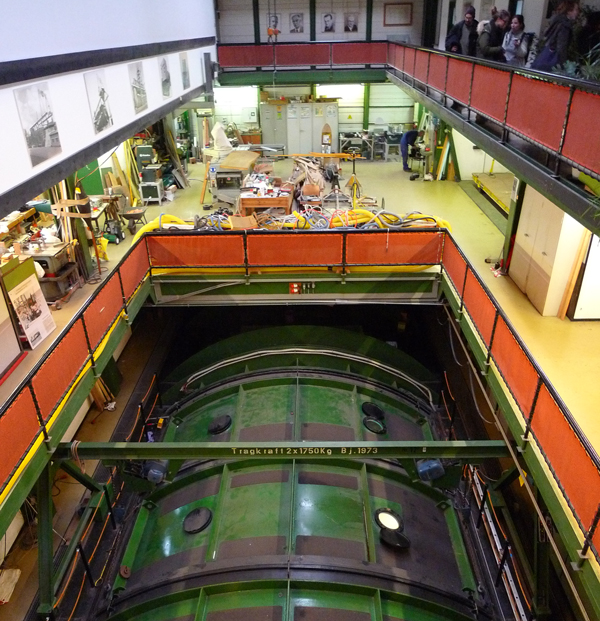
Models Are Real
Experience Experiments: Models Are RealWith Eric Ellingsen
What is a model, the Latin modulus, as vs. is, the dangers and possibilities of, from Orreries to generative non-linear models; Observer Effect; the instruments role (technological, skill, experimenter as engineer with tacit knowledge); inert material, vs. world full of agency and emergence
Readings:
Olafur Eliasson: Models are Real
Jean Baudrillard: Simulacra and Simulation
Wallace Steven: Landscape with boat
Experiment by Heinz Isler (group meets that evening outside IfREX to make model)
Excursion to the cavitation tunnel of the Versuchsanstalt für Wasserbau und Schiffbau
Experience Experiments: Modeling (Feeling your way)Mit Eric Ellingsen
What is a model, the Latin modulus, as vs. is, the dangers and possibilities of, from Orreries to generative non-linear models; Observer Effect; the instruments role (technological, skill, experimenter as engineer with tacit knowledge); inert material, vs. world full of agency and emergence
Readings:
Olafur Eliasson: Models are Real
Jean Baudrillard: Simulacra and Simulation
Wallace Steven: Landscape with boat
Experiment by Heinz Isler (group meets that evening outside IfREX to make model)
Besuch der Versuchsanstalt für Wasserbau und Schiffbau
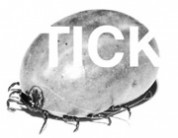
TICK
online experience art space in the form of a journal open to the world
tickjournal
TICK is curated by a rotating group of artists and writers from the Institut für Raumexperimente, UdK Berlin
ein Raum für Kunst im Netz in Form eines Magazins
tickjournal
TICK wird von einer wechselnden Gruppe von Künstlern und Schreibenden des Instituts für Raumexperimente kuratiert.

